University Ethical Clothing, Common Good, Strategies Essay
VerifiedAdded on 2022/11/18
|7
|1687
|112
Essay
AI Summary
This essay explores the intersection of ethical clothing and the concept of common good, examining the challenges within the fashion industry. It delves into issues such as exploitative labor practices, environmental damage from textile production, and animal welfare concerns. The essay discusses strategies to address these challenges, including ethical shopping, supply chain vigilance, and the role of organizations like Ethical Clothing Australia. It also analyzes the complexities of applying common good principles, considering theories like Social Choice Theory. The essay highlights the importance of organizations taking responsibility for their supply chains and the need for greater awareness of ethical issues. It underscores the impact of the fashion industry on workers, the environment, and animals, and the need for consumers to be aware of the implications of their fashion choices.
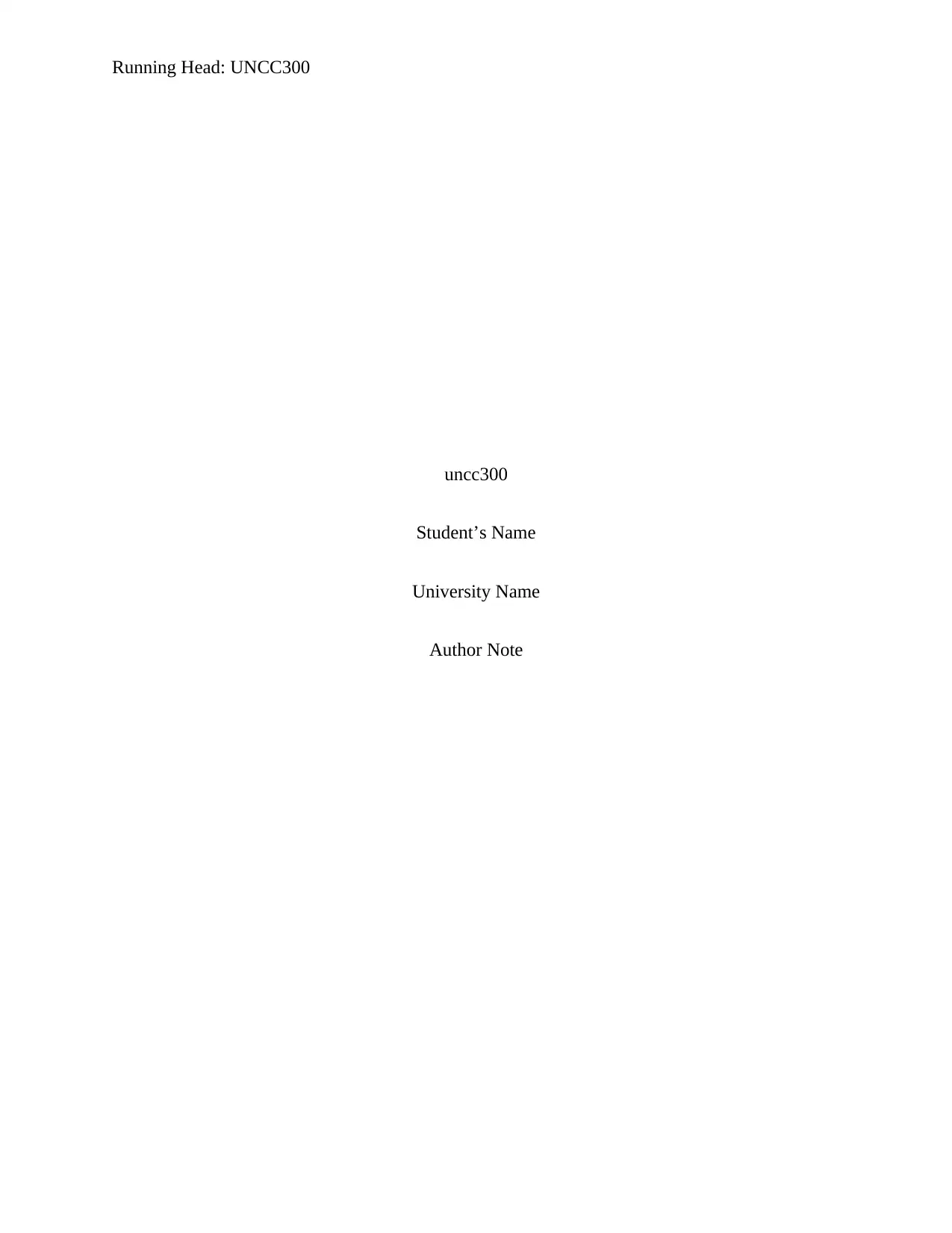
Running Head: UNCC300
uncc300
Student’s Name
University Name
Author Note
uncc300
Student’s Name
University Name
Author Note
Paraphrase This Document
Need a fresh take? Get an instant paraphrase of this document with our AI Paraphraser
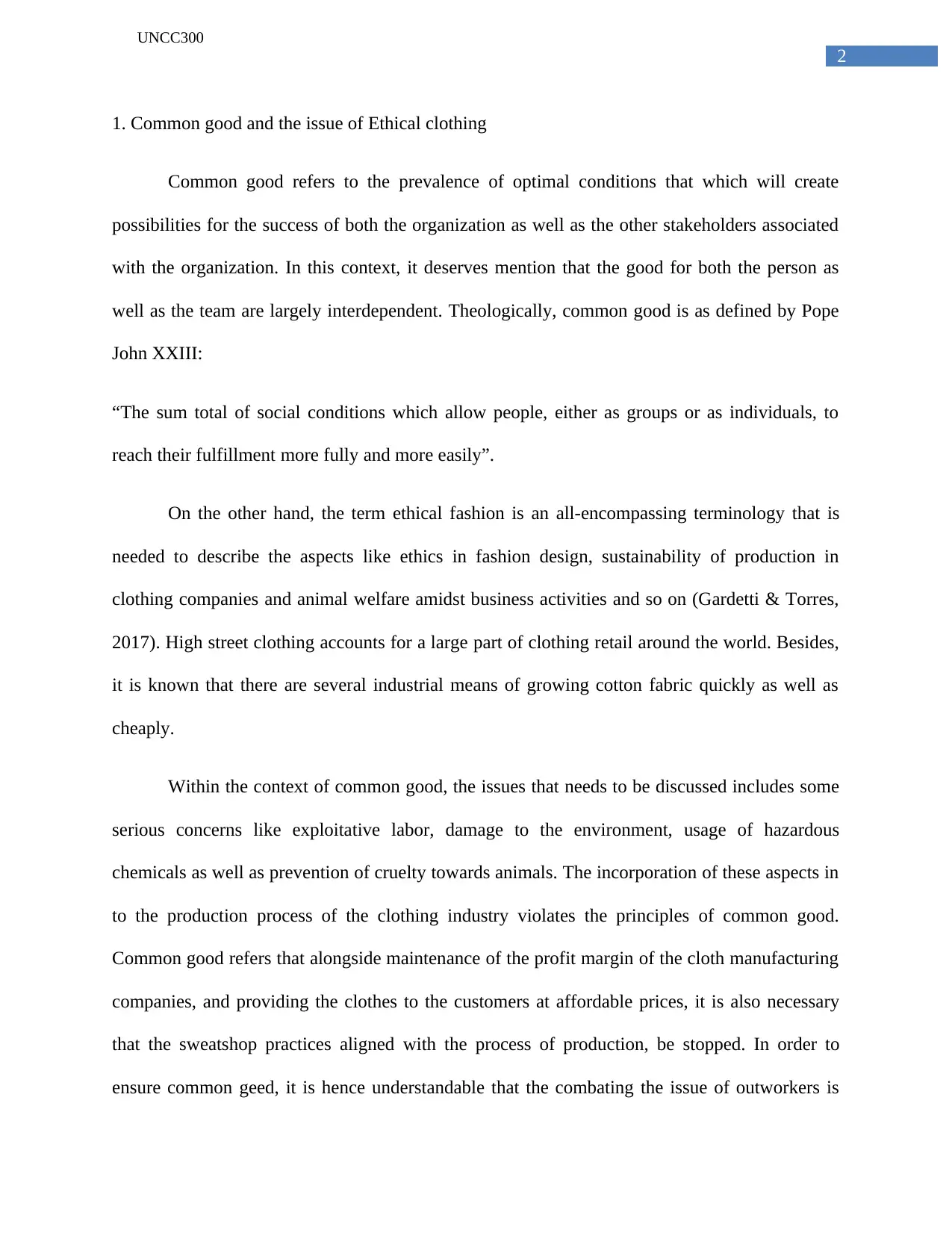
2
UNCC300
1. Common good and the issue of Ethical clothing
Common good refers to the prevalence of optimal conditions that which will create
possibilities for the success of both the organization as well as the other stakeholders associated
with the organization. In this context, it deserves mention that the good for both the person as
well as the team are largely interdependent. Theologically, common good is as defined by Pope
John XXIII:
“The sum total of social conditions which allow people, either as groups or as individuals, to
reach their fulfillment more fully and more easily”.
On the other hand, the term ethical fashion is an all-encompassing terminology that is
needed to describe the aspects like ethics in fashion design, sustainability of production in
clothing companies and animal welfare amidst business activities and so on (Gardetti & Torres,
2017). High street clothing accounts for a large part of clothing retail around the world. Besides,
it is known that there are several industrial means of growing cotton fabric quickly as well as
cheaply.
Within the context of common good, the issues that needs to be discussed includes some
serious concerns like exploitative labor, damage to the environment, usage of hazardous
chemicals as well as prevention of cruelty towards animals. The incorporation of these aspects in
to the production process of the clothing industry violates the principles of common good.
Common good refers that alongside maintenance of the profit margin of the cloth manufacturing
companies, and providing the clothes to the customers at affordable prices, it is also necessary
that the sweatshop practices aligned with the process of production, be stopped. In order to
ensure common geed, it is hence understandable that the combating the issue of outworkers is
UNCC300
1. Common good and the issue of Ethical clothing
Common good refers to the prevalence of optimal conditions that which will create
possibilities for the success of both the organization as well as the other stakeholders associated
with the organization. In this context, it deserves mention that the good for both the person as
well as the team are largely interdependent. Theologically, common good is as defined by Pope
John XXIII:
“The sum total of social conditions which allow people, either as groups or as individuals, to
reach their fulfillment more fully and more easily”.
On the other hand, the term ethical fashion is an all-encompassing terminology that is
needed to describe the aspects like ethics in fashion design, sustainability of production in
clothing companies and animal welfare amidst business activities and so on (Gardetti & Torres,
2017). High street clothing accounts for a large part of clothing retail around the world. Besides,
it is known that there are several industrial means of growing cotton fabric quickly as well as
cheaply.
Within the context of common good, the issues that needs to be discussed includes some
serious concerns like exploitative labor, damage to the environment, usage of hazardous
chemicals as well as prevention of cruelty towards animals. The incorporation of these aspects in
to the production process of the clothing industry violates the principles of common good.
Common good refers that alongside maintenance of the profit margin of the cloth manufacturing
companies, and providing the clothes to the customers at affordable prices, it is also necessary
that the sweatshop practices aligned with the process of production, be stopped. In order to
ensure common geed, it is hence understandable that the combating the issue of outworkers is
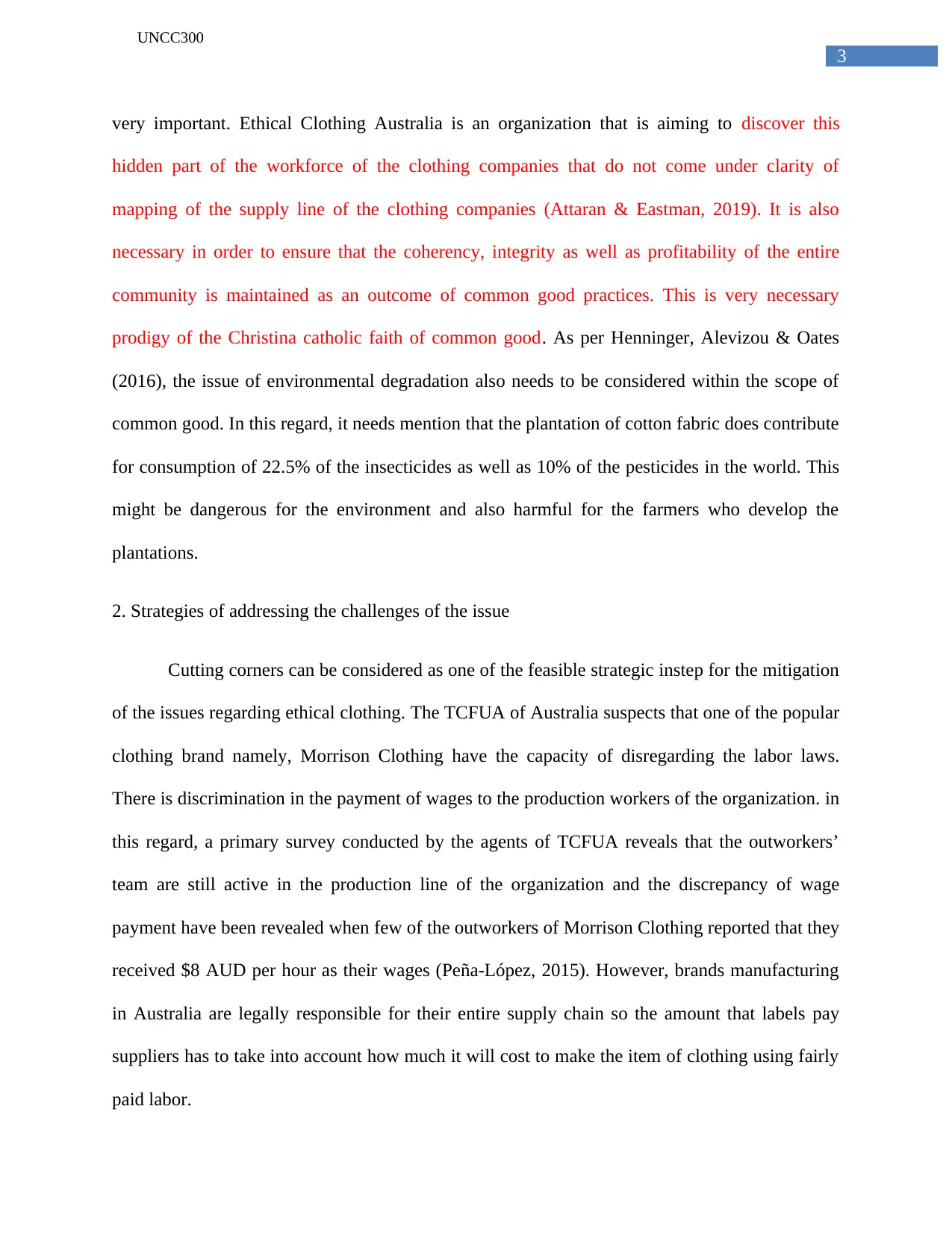
3
UNCC300
very important. Ethical Clothing Australia is an organization that is aiming to discover this
hidden part of the workforce of the clothing companies that do not come under clarity of
mapping of the supply line of the clothing companies (Attaran & Eastman, 2019). It is also
necessary in order to ensure that the coherency, integrity as well as profitability of the entire
community is maintained as an outcome of common good practices. This is very necessary
prodigy of the Christina catholic faith of common good. As per Henninger, Alevizou & Oates
(2016), the issue of environmental degradation also needs to be considered within the scope of
common good. In this regard, it needs mention that the plantation of cotton fabric does contribute
for consumption of 22.5% of the insecticides as well as 10% of the pesticides in the world. This
might be dangerous for the environment and also harmful for the farmers who develop the
plantations.
2. Strategies of addressing the challenges of the issue
Cutting corners can be considered as one of the feasible strategic instep for the mitigation
of the issues regarding ethical clothing. The TCFUA of Australia suspects that one of the popular
clothing brand namely, Morrison Clothing have the capacity of disregarding the labor laws.
There is discrimination in the payment of wages to the production workers of the organization. in
this regard, a primary survey conducted by the agents of TCFUA reveals that the outworkers’
team are still active in the production line of the organization and the discrepancy of wage
payment have been revealed when few of the outworkers of Morrison Clothing reported that they
received $8 AUD per hour as their wages (Peña-López, 2015). However, brands manufacturing
in Australia are legally responsible for their entire supply chain so the amount that labels pay
suppliers has to take into account how much it will cost to make the item of clothing using fairly
paid labor.
UNCC300
very important. Ethical Clothing Australia is an organization that is aiming to discover this
hidden part of the workforce of the clothing companies that do not come under clarity of
mapping of the supply line of the clothing companies (Attaran & Eastman, 2019). It is also
necessary in order to ensure that the coherency, integrity as well as profitability of the entire
community is maintained as an outcome of common good practices. This is very necessary
prodigy of the Christina catholic faith of common good. As per Henninger, Alevizou & Oates
(2016), the issue of environmental degradation also needs to be considered within the scope of
common good. In this regard, it needs mention that the plantation of cotton fabric does contribute
for consumption of 22.5% of the insecticides as well as 10% of the pesticides in the world. This
might be dangerous for the environment and also harmful for the farmers who develop the
plantations.
2. Strategies of addressing the challenges of the issue
Cutting corners can be considered as one of the feasible strategic instep for the mitigation
of the issues regarding ethical clothing. The TCFUA of Australia suspects that one of the popular
clothing brand namely, Morrison Clothing have the capacity of disregarding the labor laws.
There is discrimination in the payment of wages to the production workers of the organization. in
this regard, a primary survey conducted by the agents of TCFUA reveals that the outworkers’
team are still active in the production line of the organization and the discrepancy of wage
payment have been revealed when few of the outworkers of Morrison Clothing reported that they
received $8 AUD per hour as their wages (Peña-López, 2015). However, brands manufacturing
in Australia are legally responsible for their entire supply chain so the amount that labels pay
suppliers has to take into account how much it will cost to make the item of clothing using fairly
paid labor.
⊘ This is a preview!⊘
Do you want full access?
Subscribe today to unlock all pages.

Trusted by 1+ million students worldwide
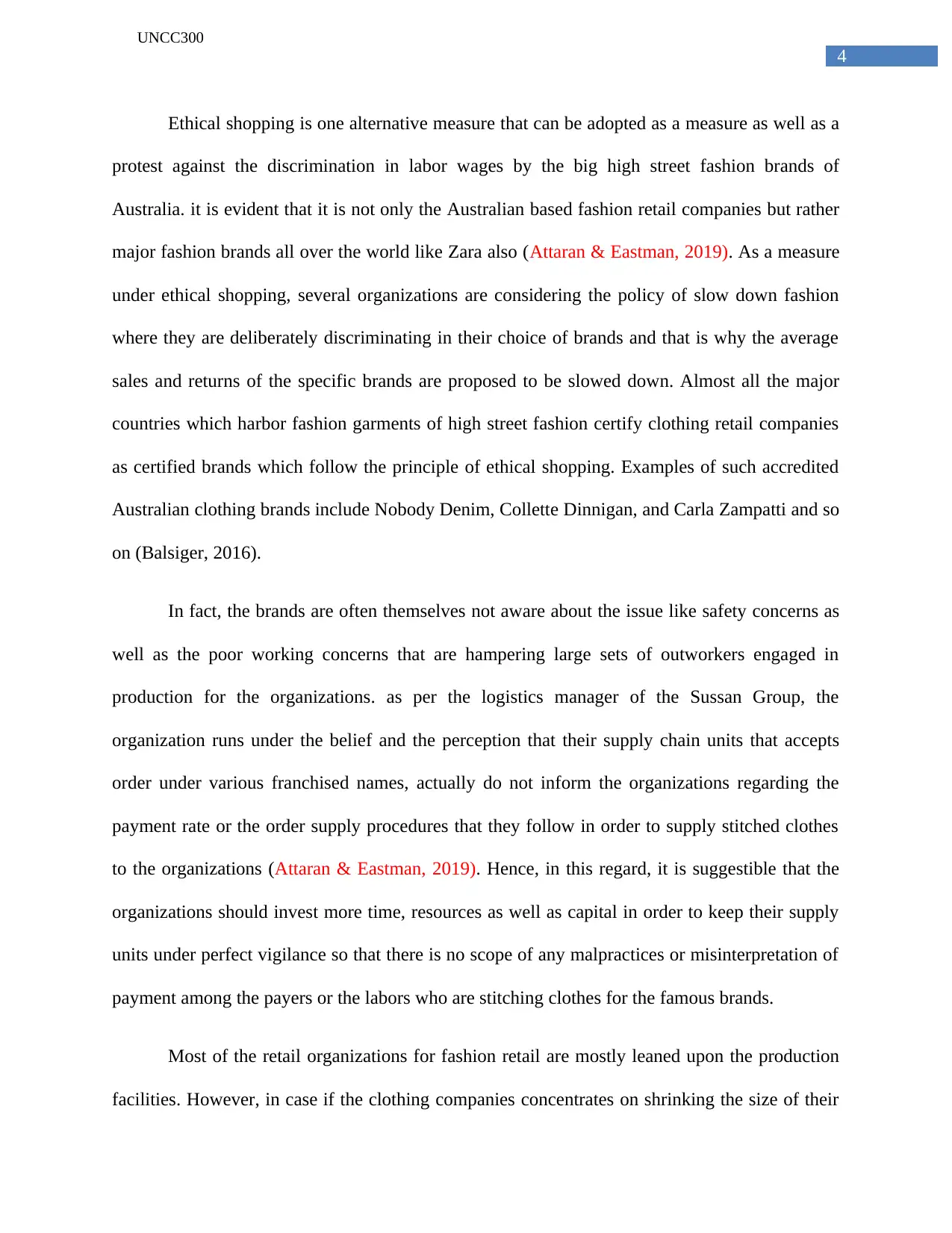
4
UNCC300
Ethical shopping is one alternative measure that can be adopted as a measure as well as a
protest against the discrimination in labor wages by the big high street fashion brands of
Australia. it is evident that it is not only the Australian based fashion retail companies but rather
major fashion brands all over the world like Zara also (Attaran & Eastman, 2019). As a measure
under ethical shopping, several organizations are considering the policy of slow down fashion
where they are deliberately discriminating in their choice of brands and that is why the average
sales and returns of the specific brands are proposed to be slowed down. Almost all the major
countries which harbor fashion garments of high street fashion certify clothing retail companies
as certified brands which follow the principle of ethical shopping. Examples of such accredited
Australian clothing brands include Nobody Denim, Collette Dinnigan, and Carla Zampatti and so
on (Balsiger, 2016).
In fact, the brands are often themselves not aware about the issue like safety concerns as
well as the poor working concerns that are hampering large sets of outworkers engaged in
production for the organizations. as per the logistics manager of the Sussan Group, the
organization runs under the belief and the perception that their supply chain units that accepts
order under various franchised names, actually do not inform the organizations regarding the
payment rate or the order supply procedures that they follow in order to supply stitched clothes
to the organizations (Attaran & Eastman, 2019). Hence, in this regard, it is suggestible that the
organizations should invest more time, resources as well as capital in order to keep their supply
units under perfect vigilance so that there is no scope of any malpractices or misinterpretation of
payment among the payers or the labors who are stitching clothes for the famous brands.
Most of the retail organizations for fashion retail are mostly leaned upon the production
facilities. However, in case if the clothing companies concentrates on shrinking the size of their
UNCC300
Ethical shopping is one alternative measure that can be adopted as a measure as well as a
protest against the discrimination in labor wages by the big high street fashion brands of
Australia. it is evident that it is not only the Australian based fashion retail companies but rather
major fashion brands all over the world like Zara also (Attaran & Eastman, 2019). As a measure
under ethical shopping, several organizations are considering the policy of slow down fashion
where they are deliberately discriminating in their choice of brands and that is why the average
sales and returns of the specific brands are proposed to be slowed down. Almost all the major
countries which harbor fashion garments of high street fashion certify clothing retail companies
as certified brands which follow the principle of ethical shopping. Examples of such accredited
Australian clothing brands include Nobody Denim, Collette Dinnigan, and Carla Zampatti and so
on (Balsiger, 2016).
In fact, the brands are often themselves not aware about the issue like safety concerns as
well as the poor working concerns that are hampering large sets of outworkers engaged in
production for the organizations. as per the logistics manager of the Sussan Group, the
organization runs under the belief and the perception that their supply chain units that accepts
order under various franchised names, actually do not inform the organizations regarding the
payment rate or the order supply procedures that they follow in order to supply stitched clothes
to the organizations (Attaran & Eastman, 2019). Hence, in this regard, it is suggestible that the
organizations should invest more time, resources as well as capital in order to keep their supply
units under perfect vigilance so that there is no scope of any malpractices or misinterpretation of
payment among the payers or the labors who are stitching clothes for the famous brands.
Most of the retail organizations for fashion retail are mostly leaned upon the production
facilities. However, in case if the clothing companies concentrates on shrinking the size of their
Paraphrase This Document
Need a fresh take? Get an instant paraphrase of this document with our AI Paraphraser
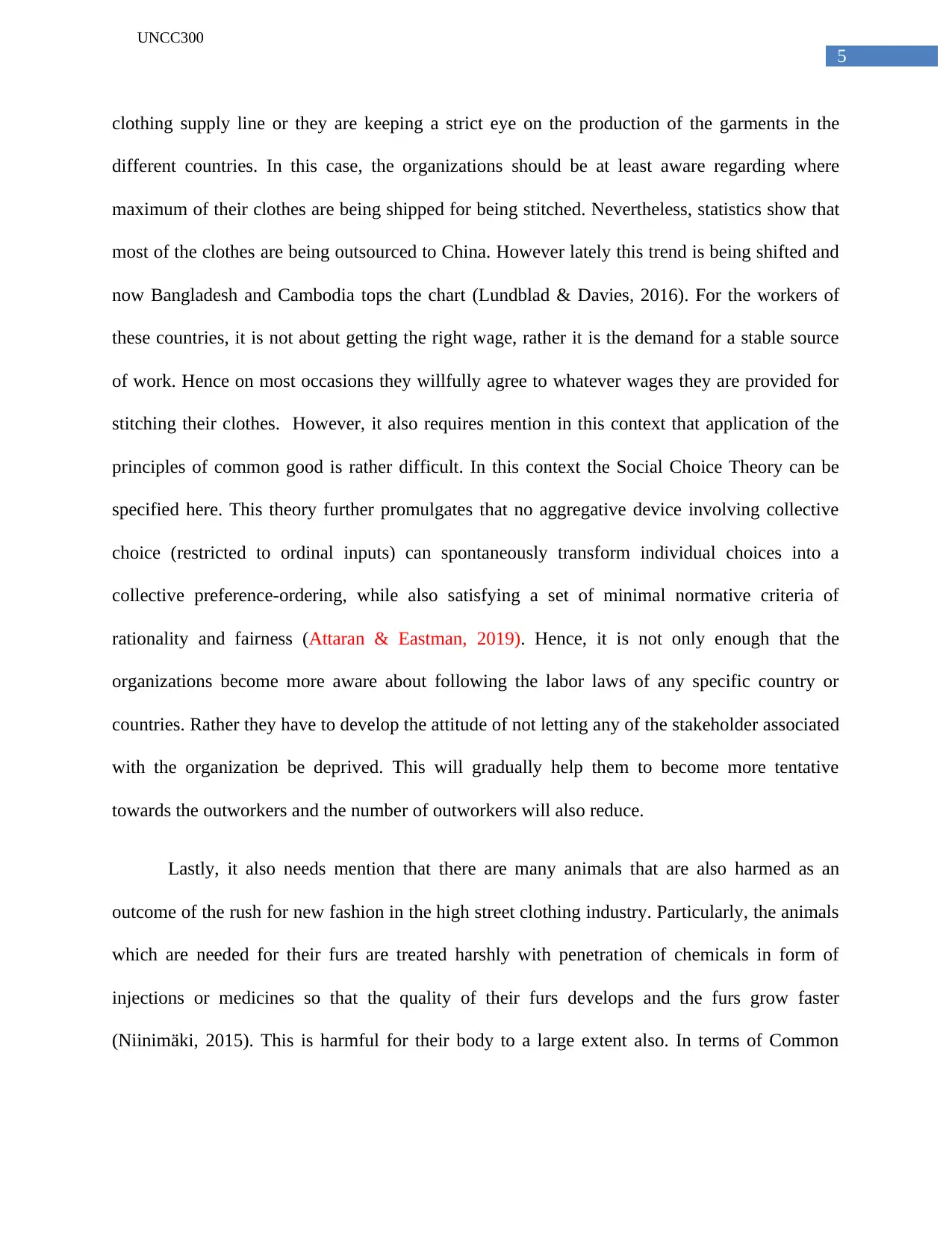
5
UNCC300
clothing supply line or they are keeping a strict eye on the production of the garments in the
different countries. In this case, the organizations should be at least aware regarding where
maximum of their clothes are being shipped for being stitched. Nevertheless, statistics show that
most of the clothes are being outsourced to China. However lately this trend is being shifted and
now Bangladesh and Cambodia tops the chart (Lundblad & Davies, 2016). For the workers of
these countries, it is not about getting the right wage, rather it is the demand for a stable source
of work. Hence on most occasions they willfully agree to whatever wages they are provided for
stitching their clothes. However, it also requires mention in this context that application of the
principles of common good is rather difficult. In this context the Social Choice Theory can be
specified here. This theory further promulgates that no aggregative device involving collective
choice (restricted to ordinal inputs) can spontaneously transform individual choices into a
collective preference-ordering, while also satisfying a set of minimal normative criteria of
rationality and fairness (Attaran & Eastman, 2019). Hence, it is not only enough that the
organizations become more aware about following the labor laws of any specific country or
countries. Rather they have to develop the attitude of not letting any of the stakeholder associated
with the organization be deprived. This will gradually help them to become more tentative
towards the outworkers and the number of outworkers will also reduce.
Lastly, it also needs mention that there are many animals that are also harmed as an
outcome of the rush for new fashion in the high street clothing industry. Particularly, the animals
which are needed for their furs are treated harshly with penetration of chemicals in form of
injections or medicines so that the quality of their furs develops and the furs grow faster
(Niinimäki, 2015). This is harmful for their body to a large extent also. In terms of Common
UNCC300
clothing supply line or they are keeping a strict eye on the production of the garments in the
different countries. In this case, the organizations should be at least aware regarding where
maximum of their clothes are being shipped for being stitched. Nevertheless, statistics show that
most of the clothes are being outsourced to China. However lately this trend is being shifted and
now Bangladesh and Cambodia tops the chart (Lundblad & Davies, 2016). For the workers of
these countries, it is not about getting the right wage, rather it is the demand for a stable source
of work. Hence on most occasions they willfully agree to whatever wages they are provided for
stitching their clothes. However, it also requires mention in this context that application of the
principles of common good is rather difficult. In this context the Social Choice Theory can be
specified here. This theory further promulgates that no aggregative device involving collective
choice (restricted to ordinal inputs) can spontaneously transform individual choices into a
collective preference-ordering, while also satisfying a set of minimal normative criteria of
rationality and fairness (Attaran & Eastman, 2019). Hence, it is not only enough that the
organizations become more aware about following the labor laws of any specific country or
countries. Rather they have to develop the attitude of not letting any of the stakeholder associated
with the organization be deprived. This will gradually help them to become more tentative
towards the outworkers and the number of outworkers will also reduce.
Lastly, it also needs mention that there are many animals that are also harmed as an
outcome of the rush for new fashion in the high street clothing industry. Particularly, the animals
which are needed for their furs are treated harshly with penetration of chemicals in form of
injections or medicines so that the quality of their furs develops and the furs grow faster
(Niinimäki, 2015). This is harmful for their body to a large extent also. In terms of Common

6
UNCC300
good there is no latent policy for prevention of such practices. There should be more protest from
public forums regarding this so that all round ethical fashion can be ensured.
UNCC300
good there is no latent policy for prevention of such practices. There should be more protest from
public forums regarding this so that all round ethical fashion can be ensured.
⊘ This is a preview!⊘
Do you want full access?
Subscribe today to unlock all pages.

Trusted by 1+ million students worldwide

7
UNCC300
Reference List
Attaran, S., & Eastman, V. (2019). BRANDING ETHICAL FASHION: THE EFFECT OF
BRAND MESSAGING ON CONSUMER PERCEPTIONS OF ETHICAL FASHION
BRANDS. Global Fashion Management Conference, 2019, 613-613. doi:
10.15444/gfmc2019.06.03.01
Balsiger, P. (2016). The fight for ethical fashion: The origins and interactions of the Clean
Clothes Campaign. Routledge.
Ethical Fashion - Victoria and Albert Museum. (2019). Retrieved 18 July 2019, from
http://www.vam.ac.uk/content/articles/w/what-is-ethical-fashion/
Gardetti, M. A., & Torres, A. L. (2017). Sustainability in fashion and textiles: values, design,
production and consumption. Routledge.
Henninger, C. E., Alevizou, P. J., & Oates, C. J. (2016). What is sustainable fashion?. Journal of
Fashion Marketing and Management: An International Journal, 20(4), 400-416.
Lundblad, L., & Davies, I. A. (2016). The values and motivations behind sustainable fashion
consumption. Journal of Consumer Behaviour, 15(2), 149-162.
Niinimäki, K. (2015). Ethical foundations in sustainable fashion. Textiles and Clothing
Sustainability, 1(1), 3.
Peña-López, I. (2015). Rethinking Education. Towards a global common good?.
UNCC300
Reference List
Attaran, S., & Eastman, V. (2019). BRANDING ETHICAL FASHION: THE EFFECT OF
BRAND MESSAGING ON CONSUMER PERCEPTIONS OF ETHICAL FASHION
BRANDS. Global Fashion Management Conference, 2019, 613-613. doi:
10.15444/gfmc2019.06.03.01
Balsiger, P. (2016). The fight for ethical fashion: The origins and interactions of the Clean
Clothes Campaign. Routledge.
Ethical Fashion - Victoria and Albert Museum. (2019). Retrieved 18 July 2019, from
http://www.vam.ac.uk/content/articles/w/what-is-ethical-fashion/
Gardetti, M. A., & Torres, A. L. (2017). Sustainability in fashion and textiles: values, design,
production and consumption. Routledge.
Henninger, C. E., Alevizou, P. J., & Oates, C. J. (2016). What is sustainable fashion?. Journal of
Fashion Marketing and Management: An International Journal, 20(4), 400-416.
Lundblad, L., & Davies, I. A. (2016). The values and motivations behind sustainable fashion
consumption. Journal of Consumer Behaviour, 15(2), 149-162.
Niinimäki, K. (2015). Ethical foundations in sustainable fashion. Textiles and Clothing
Sustainability, 1(1), 3.
Peña-López, I. (2015). Rethinking Education. Towards a global common good?.
1 out of 7
Related Documents
Your All-in-One AI-Powered Toolkit for Academic Success.
+13062052269
info@desklib.com
Available 24*7 on WhatsApp / Email
![[object Object]](/_next/static/media/star-bottom.7253800d.svg)
Unlock your academic potential
Copyright © 2020–2025 A2Z Services. All Rights Reserved. Developed and managed by ZUCOL.





